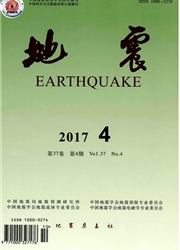

 中文摘要:
中文摘要:
利用1-Hz GPS数据反演2011年3月日本东北大地震的时空破裂过程,通过理论波形图与观测波形图的拟合,以及ABIC准则的判定,反演得到滑移分布的稳定估计。结果表明:破裂集中在震源附近,并在震中以下30km处达到最大位错量,约72m,在岩手和福岛靠近海岸线处有两个较小的破裂区,断层的南半段破裂很小,同时也是余震最为密集的地方。整个破裂过程由3个破裂阶段组成,发震后断层从震源向周围缓慢破裂,在50~60s破裂延伸至地表(海沟);60~90s在震中下方迅速发生强烈破裂,形成了最大位错区,这一阶段主要是倾向上的双边破裂;90~120s在断层最北西处和断层南半段发生较小破裂,整个破裂过程持续大约120s。反演得到的地震矩为3.8×1022 Nm,相应的矩震级为MW9.0。
 英文摘要:
英文摘要:
The space-time rupture process of the March 2011 great northeast Japan earthquake is obtained by inversion of 1-Hz GPS data.The inversion compares observation waveforms with synthetic waveforms on the basis of ABIC method,yielding stable estimates of the slip distribution.The solution has concentrations of slip near the hypocenter,with maximum slip of ~72 m beneath the hypocenter of 30 km.There are two concentrations of smaller slip in Iwate and Fukushima close to the coast.The southern fault has general small slip,with the highest concentrations of aftershocks.The complete rupture consists of three main ruptures.After the initial break,the rupture propagates around from the hypocenter with small velocity,and then it expands to the trench within 50 s to 60 s.The large rupture occurs quickly beneath the hypocenter from 60 s to 90 s,forming the largest slip region.The main rupture propagates bilaterally up-dip and down-dip.From 90 s to 120 s,the rupture with small slip concentrates in the most northwestern area and in the southern half of the fault.The entire rupture almost ceases within 120 s.The solution of inversion suggests that the seismic moment is 3.8×1022 Nm,and the corresponding moment magnitude is MW9.0.
 同期刊论文项目
同期刊论文项目
 同项目期刊论文
同项目期刊论文
 期刊信息
期刊信息
